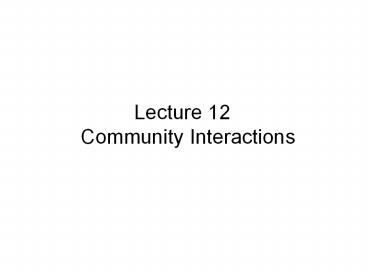Lecture 12 Community Interactions - PowerPoint PPT Presentation
Title:
Lecture 12 Community Interactions
Description:
Mutualism Both participating species benefit ... Brood parasitism. common in birds within species non-obligate. Obligate brood parasites: Cuckoo. Cowbird ... – PowerPoint PPT presentation
Number of Views:46
Avg rating:3.0/5.0
Title: Lecture 12 Community Interactions
1
Lecture 12 Community Interactions
2
- Types of Interactions Within A Community
- Competition
- Predation
- Symbiosis two (or more) kinds of organisms live
together in close association - Three kinds
- Mutualism Both participating species benefit
- Commensalism One species benefits and the other
neither benefits nor is harmed - Parasitism One species benefits while the other
is harmed
3
- Competition is the struggle of two organisms to
use the same resource ie. share same niche - any use .. of a resource by one species
reducing its availability to another species - Interspecific competition between species
- Intraspecific competition within species
- Outcome varies
- One species may be eliminated
- Both may persist but at decreased population
levels - Niche is divided
- Fundamental niche
- Realized niche
4
- Interspecific competition and relatedness
- Darwin greater competition between related spp.
- Many exceptions convergence/food in webs
- Species of intertidal
- Species feeding on krill
- Species feeding on inverts of forest litter
5
- Competitive Exclusion
- In the 1930s, G.F. Gause studied interspecific
competition among three species of Paramecium - P. aurelia P. caudatum P. bursaria
- All three grew well alone in culture tubes
6
- However, P. caudatum declined to extinction when
grown with P. aurelia
- The two shared the same realized niche and P.
aurelia was better competitor
- Gause formulated the principle of competitive
exclusion - No two species with the same niche can coexist
- What parameter (think about evolutionary
processes) results in survival of one species, to
the exclusion of another (or others)? - Is one competitor always eliminated from the
habitat?
7
- P. caudatum and P. bursaria were able to coexist
- The two have different realized niches and thus
avoid competition
- Gauses principle of competitive exclusion can be
restated - No two species can occupy the same niche
indefinitely - When niches overlap, two outcomes are possible
- Competitive exclusion or resource partitioning
8
Resource Partitioning
- Persistent competition is rare in natural
communities - Either one species drives the other to extinction
- Or natural selection reduces the competition
between them
- Five species of warblers subdivided a niche to
avoid direct competition with one another
9
- Asymmetric Competition
- Results in division of niche ? realized niche of
each - Determined by competion/competator
- each exists in microhabitat
- Connell study of interspecific competition
between Chthamalus stellatus and Balanus
balanides
10
- Mutualism
- Interactions between individuals of different
species that benefit both partners. - Facultative Mutualism occurs when a species can
live without its mutualistic partner. - Obligate Mutualism occurs when a species is
dependent on a mutualistic relationship.
11
- Animal Animal Mutualism
- Ants and Aphids
- Aphids provide the ants with food in the form of
continuously excreted honeydew
- Ants transport the aphids and protect them from
predators
12
Ants and Bullshorn Acacia
- Herbivores attempting to forage on accacia plants
occupied by accacia ants are met by a large
number of fast, agile, highly-aggressive
defenders. - Ant Benefits
- Thorns provide living space.
- Foliar nectaries provide sugar.
- Beltian bodies are a source of oils and protein.
13
- Mycorrhizae
- Plant Fungus mutualistic relationship
- Fungus benefits from carbohydrate nutrition
provided by plant - Plant benefit
- Fungus provides increased access to water and
soil nutrients - In many cases plants cannot effectively become
established without mycorrhizal association
14
(No Transcript)
15
Plant Performance and Mycorrhizal Fungi
- Two most common types of mycorrhizae
- Arbuscular mycorrhizal fungi (AMF)
- Produces arbuscules - site of exchange between
plants and fungi, hyphae - fungal filaments, and
vesicles - energy storage organs. - Ectomycorrhizae (ECM)
- Forms mantle around roots - important in
increasing plant access to phosphorus and other
immobile nutrients.
16
- Animals and Evolution of Flowering Plants
Mutualism and Coevolution - Two levels
- Movement of male gametophyte plant (pollen)
- Wind random, not efficient
- Coevolution with pollinators
- Movement of pollen more reliable
- Dispersal
- Heavy seed reserves for developing plant
- Efficient dispersal relies on mechanical
transport by animals
17
- Parasitic Relationships
- Host
- Parasite types
- Based on size
- Microparasite
- Macroparasite
- parasitioids
- Based on living within or on outside of host
- Ectoparasite
- Endoparasite
- Relationship with Host
- Obligate parasites
- Facultative parasites
18
- Parasite Life Cycle
- may involve multiple hosts
- Definitive host supports maturation of parasite
- Intermediate host harbor developmental phase(s)
- Sometimes several
- Vector
- Alternate hosts
- Reservoir host(s) alternate hosts
19
(No Transcript)
20
- Parasite Impacts on Host
- Balanced host-parasite relationship tolerant
- Host survives often with less vigor
- Parasite multiplies
- Balance altered
- High host mortality
- Possibly decreased parasite multiplication
- Reduced host fitness
- Altered host behavior
21
(No Transcript)
22
- Brood parasitism
- common in birds within species non-obligate
- Obligate brood parasites
- Cuckoo
- Cowbird
- Host species react by ejecting eggs of parasite
from next - May be severely affected if behaviors not evolved
- Kirklands warbler
23
(No Transcript)































